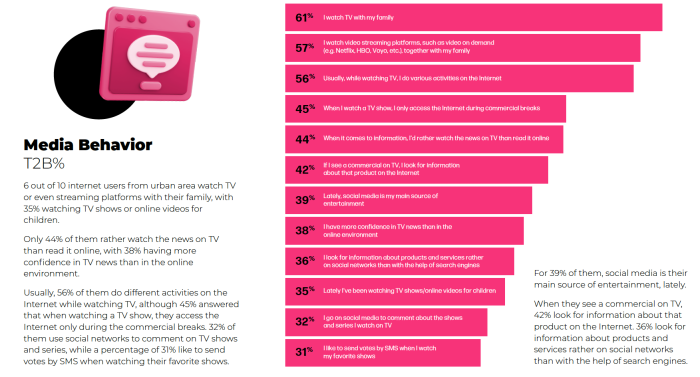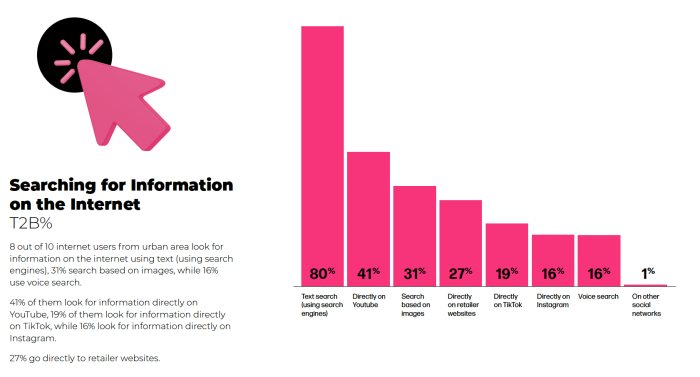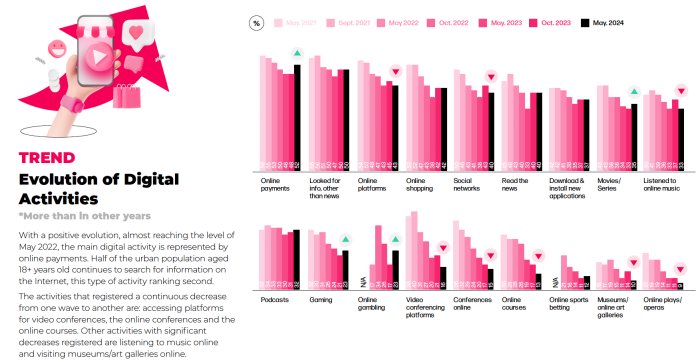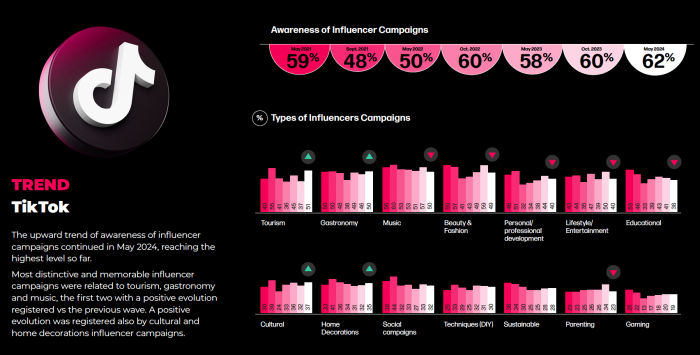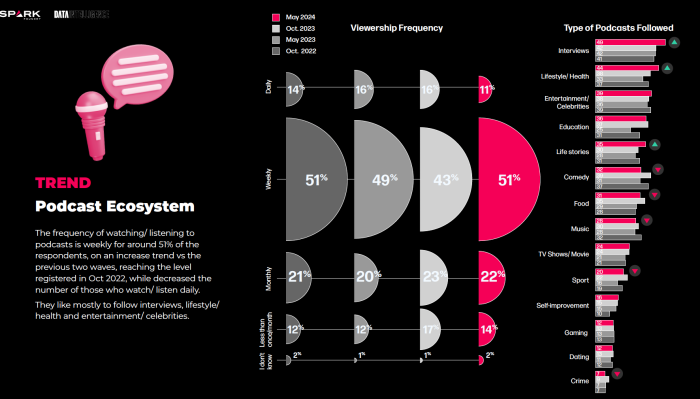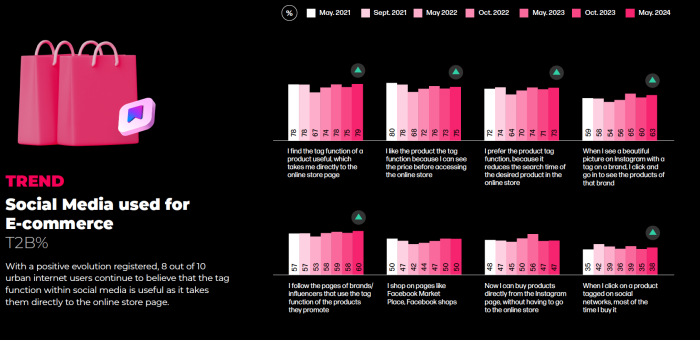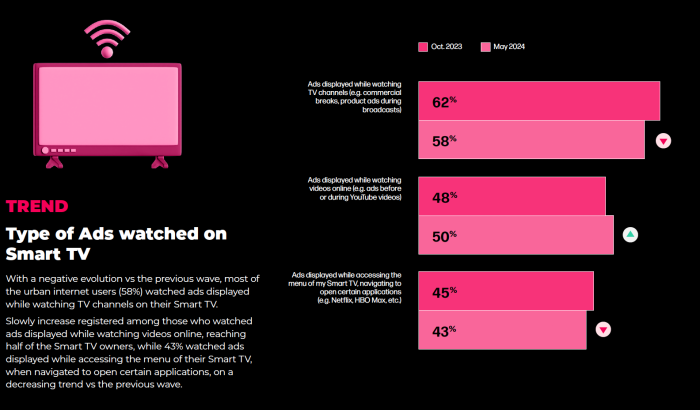- Accessing videoconferencing platforms, the conferences, and the online courses have been consistently declining from one wave to the other.
- Young people are diversifying their online searches, increasingly using images, voice search, and obtaining information directly from the retailer websites.
- Pinterest is the only social media platform with growth (+4%), being more frequently used by young people aged 18 to 24.
- The greatest attention is given to information from online videos (YouTube), followed by those provided by traditional TV and by on-demand video content (Netflix, HBO, etc.).
- A 6% decrease compared to the previous wave among those who watch online content on Smart TVs exclusively by subscription (e.g., Netflix, HBO, Voyo, etc.), in favor of those who watch both, with and without a subscription.
According to the Romanians New Media Adoption study conducted by the Data Intelligence team of Spark Foundry, a media agency part of Publicis Groupe Romania, internet users continue to access social media platforms and video-on-demand platforms, while interest in audio content platforms is declining.
At the top of the social media platforms is Facebook, followed by Instagram, then by TikTok. Facebook and TikTok have remained constant compared to the previous analysis, while Instagram has experienced a slight decline. Pinterest was the only platform with a positive evolution registered, in May 2024 compared to the previous waves.
Influencer campaigns on TikTok continued to gain notoriety in May 2024, reaching the highest level so far. The most remarkable campaigns on TikTok were in the fields of tourism, gastronomy, and music, with the first two showing growth compared to the previous analysis in October 2023.
The study is part of Focus On: New Media Usage, a series of reports that track the evolution of media consumption behaviors based on quantitative studies. This report was conducted in May 2024, being the first of the two annual reports in the series.
“There are significant differences in the media behavior between different age groups. Younger individuals prefer to engage in online activities while watching TV content, with social media being their main source of entertainment, while older individuals tend to rely more on news and information seen on television, using the internet only during commercial breaks. Additionally, the reaction to TV advertisements varies by age group, with younger people searching for information on social networks, while older individuals are more likely to use search engines for information. We also observe a general trend of consuming TV and streaming content together with their families, with 35% watching children’s TV shows or online videos, also with significant differences between different age groups. Young people prefer streaming platforms to watch content with their families, while older people choose watching TV content to enjoy with their loved ones.” stated Mădălina Bâdea, Head of Data Insights, Spark Foundry.
In addition to the well-established information, the current report also brings new insights regarding the use of artificial intelligence, attention to different media types, media behaviours, ways of searching for information on the internet, and interest in current year’s events.
According to the study, only 30% of the urban internet users utilize artificial intelligence. Among these, 57% use AI for Chat, 46% use it to generate images, 36% use AI to analyse documents, while 28% use it to generate videos.
1. Attention to Different Media Types
Urban internet users primarily focus (56%) on information provided through online videos (YouTube), followed by traditional TV (52%), and video-on-demand content (51%), such as Netflix, HBO, etc. Print media ranks last with only 35%.
Analysing the data by age groups, the people aged between 18-34 years old pay attention mainly to the information provided by Online Video (YouTube), by Video on Demand and by Podcasts, while those aged between 18-24 years old pay attention to social media.
Radio and online press information capture the attention mainly of the people aged 35 and over years old, those from the print media capture the attention of people aged between 18-24 years old and 35-44 years old, while the information from Classic TV captures the attention of people over 55 years old.
2. Media Behavior – TV vs. Internet
6 out of 10 urban internet users watch television or even streaming platforms together with their family, with 35% watching TV shows or online videos for children.
Only 44% of them rather watch the news on TV than read it online, with 38% having more confidence in TV news than in the online environment.
Usually, 56% of them do different activities on the Internet while watching TV, although 45% answered that when watching a TV show, they access the Internet only during the commercial breaks. 32% of them use social networks to comment on TV shows and series, while a percentage of 31% like to send votes by SMS when watching their favorite shows.
For 39% of them, social media is their main source of entertainment, lately.
When they see a commercial on TV, 42% look for information about that product on the Internet. 36% look for information about products and services rather on social networks than with the help of search engines.
3. Searching for Information on the Internet
8 out of 10 internet users from urban area look for information on the internet using text (using search engines), 41% of them look for information directly on YouTube, 31% search based on images, while 27% go directly to retailer websites. However, only 16% of users use voice search, 16% search for information on Instagram, and 19% perform searches directly on TikTok.
People aged 45 and over primarily search for information on the internet using text. Young people aged 18 to 24 search for information based on images and voice, or directly on YouTube, TikTok, and Instagram. Those aged 25 to 34 also search for information on TikTok.
Those who search directly on retailer websites are aged mainly 18-24 and over 55. Those over 55 also search for information directly on YouTube or Instagram, while individuals aged 35 to 44 use voice search.
4. Interest in 2024 Events
Almost half of the urban internet users are interested in all the events of 2024: elections, the European Football Championship, the Olympic Games, claiming that they will spend more time in front of the TV than usual, but also that they will read/ follow the information regarding these events online.
Those who are interested to a greater extent in the events of 2024 are those aged 45 and over years old. The people aged 25-34 years old are more interested in the elections, following the local/ international news more closely.
5. Evolution of Digital Activities
The main digital activity is represented by online payments, followed by internet information searching – activities conducted by approximately half of the urban population aged 18 and over. Activities that have consistently declined from one wave to another include accessing video conferencing platforms, as well as online conferences and courses, while other activities that have seen significant decreases are listening to music online and visiting museums or art galleries online.
6. Main Reasons for using Social Media
6 out of 10 people access social networks to fill up their spare time/ to relax, this type of activity not registering a significant fluctuation compared to the previous wave. Although it ranks second, staying connected with their friends is the activity that recorded a high decrease compared to the previous wave, being also below the levels of the other previous waves.
The people aged 45 and over years old use social media mainly to find out news about their family, friends, or colleagues, while those aged over 55 years old use social media to stay connected with their friends, to fill up their spare time/ to relax, to search for various products/ brands that they want to purchase, to support social causes and for live streaming.
Those aged between 18-24 years old use social media in a greater extent for the diversity of the content, for posting pictures/ videos, for finding out about new trends, for being up to date with the activity of their favourite brands, while those aged between 18-34 years old use social media in a greater extent to follow celebrities/ influencers.
7. Social Media platforms
The new study shows that the main Social Media platforms used by Romanians remain Facebook (90%), Instagram (57%), and TikTok (47%). Facebook and TikTok have remained nearly constant compared to the previous analysis, while Instagram has experienced a slight decline. Pinterest was the only platform that showed a positive trend (+4%).
Facebook continues to be the most used platform, especially among people over 55 years old. Those aged 18 to 34 are more attracted by platforms like Instagram and TikTok, while Snapchat, Pinterest, Reddit, Tumblr, Clubhouse, and BeReal are preferred by those aged 18-24.
8. Romanians Favorite Type of Content on Social Media
Images and videos remain the preferred types of content on social media, followed distantly by articles. While gifs have shown growth compared to the previous analysis, text and audio content have seen negative trends.
Text and audio content are popular types, especially among individuals aged 45 and older, while images, articles, and brand posts are more favored by those over 55 years old.
Instagram Stories are the most popular type of content on social networks for individuals aged 18 to 34, while those aged 18 to 24 prefer live streaming and gifs.
9. Activities on Instagram
Instagram remains popular for following friends’ and acquaintances’ posts (74%), showing an increase compared to the previous wave (+5%). Significant increases were also noted in activities such as participating in contests (+6%), sharing various videos (+6%), and clicking on tags that redirect to brand pages (+5%), while posting photos saw a slight decrease (-2%).
Watching and posting Instagram Stories, posting photos, and reacting to polls on stories are activities primarily carried out by individuals aged 18 to 24, while those aged 18 to 34 follow influencers, use different filters, and engage with IGTV.
Watching Instagram Stories is also a favored activity among those aged 45 to 55. Individuals aged 18 to 44 prefer to use the “swipe up” feature, while those aged 35 to 44 prefer to join live shows hosted by celebrities or influencers. Following posts featuring friends or acquaintances is an activity undertaken by individuals aged 45 and older, while those over 55 prefer to join various online communities.
10. TikTok and influencer campaigns
There is a slight increase in the awareness level of influencer campaigns on TikTok compared to the previous report, reaching the highest level so far.
The most notable influencer campaigns have been in sectors such as tourism, gastronomy, and music, with the first two showing growth compared to the previous report. There has been an increase in influencer campaigns also within the cultural sector and interior decoration.
11. Metaverse
In May 2024, the concept of Metaverse did not show significant evolution compared to the previous analysis.
57% of the urban internet users have heard of the “Metaverse” concept, and 61% of them would be interested in trying virtual experiences in the Metaverse. Interest is distributed as follows: 63% of the urban users are interested in concerts, 50% in socializing, 46% in education or virtual shopping, while 38% are interested in professional experiences in the Metaverse.
12. Audio content platforms and podcasts
Analysing the data, we notice a decline in the awareness of social platforms that exclusively feature audio content compared to previous reports, reaching the level of May 2022. Approximately 51% of the respondents listen to podcasts on a weekly basis, showing an upward trend compared to the two previous reports, while the number of daily listeners has decreased.
Users prefer to follow interviews, lifestyle or health-related content, as well as entertainment/ celebrities.
13. The evolution of live streaming platforms and content
Music remains the favourite type of live streaming, showing lower levels in the spring waves compared to the fall ones. Increases from the previous analysis were noted in concerts (+3%), video conferences (+2%), and cultural events (+3%).
The most used platform for live streaming remains YouTube, showing consistent evolution compared to the previous analysis. The next ranked were Facebook, TikTok, and Instagram, all three experiencing significant declines compared to the previous wave.
14. E-commerce through Social Media
With a positive evolution compared to the previous report, 8 out of 10 urban internet users continue to believe that the tagging feature in social media is useful because it directs them to the online store’s page.
15. Romanians and online games
The most important activities were playing/ downloading games on their smartphone and playing/ downloading free video games.
This wave increased the number of those who played/ downloaded games on their smartphone and the number of those who used a subscription service such as XBOX LIVE, PlayStation Plus or Steam, while those who played a network game, with people they didn’t know, didn’t have a significant evolution.
Those aged 18 to 34 are the main players on social networks and those who livestream their gaming style, while those aged 45-55 are the ones who play/download games on smartphones or play/download free video games.
4 out of 10 internet users already have a favorite type of game. We notice a negative evolution among those for whom the recommendations from friends/ colleagues/ acquaintances are important, or among those for whom is important that it is a free video game, or for which the graphics/ design of the game is important, while the positive evolution is registered among those for whom is important the fact that they can customize the game or for whom is important the storyline of the game.
People aged 25 to 34 and those over 55 are particularly interested in their favorite types of games. Young people (18-24) continue to pay special attention to graphics and recommendations from gaming influencers, while for those aged 18 to 34, recommendations from friends and the storyline of the game are important.
16. Online communities
Urban internet users have continued to join online communities, especially to connect with people who share similar interests as theirs.
There has been a positive trend among those who interact with others within the community, forging friendships. However, there has been a significant decrease (-8%) among those who participate in contests or events within the community.
17. Local targeting and Proximity Events
The data shows an insignificant evolution in the percentage of users using app features to search for events near them. Additionally, there is a slight decrease among those using location-based features and finding them useful.
On an upward trend, many people would seek more information about events after using local direction apps, while those willing to attend those events have shown a slight decline.
Events posted by brands on social media continue to generate interest, particularly among individuals aged 45 and over.
Those most willing to participate are aged between 18 and 44, while younger individuals aged 18 to 24 would seek other events by the respective brands.
18. Romanians and Smart TVs
90% of the urban internet users have at least one Smart TV in the household, on a positive evolution vs the previous waves, out of which 29% watch exclusively online content (YouTube, Netflix, HBO, Voyo etc), registering a decrease in favor of those who watch exclusively TV classic (18%) or both: TV classic and online (53%).
Majority of urban internet users (58%) have viewed advertisements while watching TV channels on Smart TVs, 50% have seen ads while watching online videos, and 43% have watched ads while navigating through the Smart TV menu to open applications.
Those who saw in a greater extent ads displayed while watching TV channels on their Smart TV are mainly aged over 55 years old. Those younger, aged 18-24 years old, saw especially ads displayed while accessing the menu of their Smart TV, while those aged between 18-34 years old saw ads displayed while watching videos online.
35% of the urban internet users watch online content on Smart TVs exclusively through subscription (e.g., Netflix, HBO, Voyo), while 17% watch exclusively without subscription (e.g., YouTube), and 49% watch both: with and without subscription. Those who prefer subscription-based content are predominantly aged between 18 and 24 years, as well as 35 to 44 years old, while individuals who access content exclusively without subscription are typically aged between 45 and 55 years. Additionally, those aged 25 to 34 years and over 55 years access both types of content, with or without subscription.
19. Video on Demand
49% of the urban internet users have at least one subscription to video streaming platforms, a decrease compared to previous waves, with most accessing them via Smart TVs (77%).
Netflix is by far the most watched platform, registering a slight increase compared to the previous analysis, followed at distance by HBO Max, then by Disney+, both with a negative trend compared to October 2023 data. SkyShowTime and Voyo have recorded significant increases compared to the two previous analyses.
Methodology
The study was conducted by the Data Intelligence team of the media agency Spark Foundry, using the CAWI (Computer Assisted Web Interviews) method, on a sample of 808 male and female internet users aged 18 and older, living in urban areas, during the period of May 15-24, 2024.
 All Publicis Groupe Romania proprietary data tools in one place.
All Publicis Groupe Romania proprietary data tools in one place.Discover the power of our tools and feel free to get in touch.




